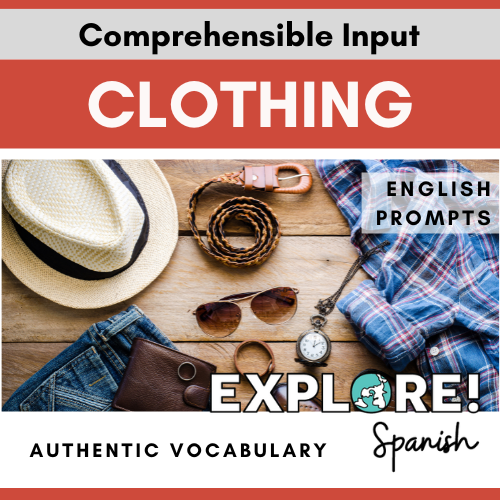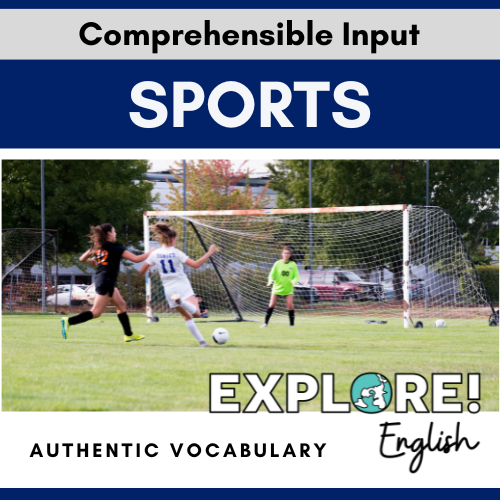Low-Prep Techniques to Differentiate Vocabulary Instruction
When students learn vocabulary from target-language sources, differentiating is easy and stress free!
Let’s peek inside my 8th grade classroom as students are using an online clothing store to explore new French vocabulary.
Student 1: “Mrs. Bartels, so some of these say the word “chemise”, some say “chemisier” and some say “t-shirt”. So what’s the word for “shirt”?
Me: “That’s a great question.”
Student 2: “Mrs. Bartels, what are these weird “E” things next to the prices?
Me: “That’s a great question.”
Student 3: “Mrs. Bartels, I was looking at this section ‘chaussures’ and I figured out that’s the shoes. And then I noticed ‘talons’ are all the high heels. And ‘sandales’ are obviously sandals. But what are “Baskets”? Are those like, shoes that lace up?
Me: “That’s a great question.”
As I analyze this conversation snippet, a few things stand out:
Each student is having some success at comprehending portions of the website.
Each student is looking at a different aspect of French clothing, yet they’re all on task.
Each student is exploring the vocabulary at different depth (the basic words / the cost / the details).
Now, I promise I do more in my classroom than say, “That’s a great question”! The exploration students are engaged in took a lot of careful thought and research on my part. I had to curate accessible target language sources and develop achievable tasks for my students. You can read more about that process at this link, and click on the images to access my large collection of Authentic Vocabulary lessons (including several freebies) on my TPT store.
Once you’ve developed a good task, turn students loose. Don’t be afraid to let them struggle a bit. Developing tolerance for ambiguity is an important part of learning language, so encourage kids to embrace the process. (I even have a blog post on the topic here!)
If the student needs a little more encouragement than “Good question”, you can:
talk them through finding an answer to their question by referring back to the source document.
Encourage the student to jot down a question and come back to it later.
I like to tell kids, “I don’t want to answer that now. I want you to struggle with it a little longer. But, I promise you’ll have an answer before you leave class today.
(And be sure to keep the promise by leaving time for questions at the end of the lesson! But - a lot of times, students figure it out on their own or with the help of classmates!
Of course, there are times when a student gets stuck and needs more direction. Here are a few low prep strategies you can implement with individual learners:
If a student is struggling, provide more structure. For example:
“Don’t be afraid to let students struggle a bit. Tolerating ambiguity is an important part language learning. Encourage kids to embrace the process!”
Provide a few specific English words to look for in the target language resource.
Provide a more limited segment of the target language resource to study. For example, instead of looking at an entire website, limit their search to one page.
Provide a paper copy of the target language resource, or copy it into a google doc. Ask the student to highlight words they already know in the target language in one color, and words that look similar to English words in another color. Then coach the student to draw some conclusions from the highlighted words.
If all else fails, give the student a list of a few English words and a few target language words, and ask them to try matching them up using only the target language resource to help.
If the student completes the activity quickly, add rigor or complication to the task. For example:
Ask the student to find adjectives related to the vocabulary they figured out. Can they determine words for colors, sizes, materials, or features?
Scan the student’s list for important words they may have missed, and challenge them to find that vocabulary.
Challenge the student to figure out grammatical structures from the source document. Can they determine which words are masculine / feminine? Can they find patterns of adjective agreement or irregular adjectives? Can they find examples of negation or of current verb structures?
Encourage the student to look at product reviews on the website. Can the student find positive / negative phrases in reviews? Are there any examples of slang?
Have the student choose a product and write their own review. Or, have them write a response to an online review.
A few cautions about this approach:
The siren song of Google Translate is irresistible to some students. You have to train them and work with them not to use it. I’ve had success in telling kids “Don’t use a translator yet.. I’ll give you 5 minutes later in the lesson where you can use an online dictionary to answer your questions. This works for many students, but it’s something you will have to regularly reinforce.
If students are new to this approach to vocabulary introduction, it may help to complete some answers as a full class. Do a ‘think aloud’ to demonstrate your own process to figure out vocabulary, as if you have a similar target language level as your students. Share your thought process aloud, and model learning strategies such as using the images, building on known words, using cognates, looking for common words in the descriptions, and jotting down questions to come back to later.
As teachers we do these things without realizing it. Our students may not - so we must model and provide practice.
After a few months in my class, Ethan called me over. “Mrs. Bartels, I can’t figure out the word for ‘kitchen’. It keeps saying ‘cuisine’ but that means ‘cook.’
As I opened my mouth to reply, Ethan teased me. “Let me guess - ‘that’s a good question’.”
I smiled. “That IS what I was going to say. But I also wanted to tell you, you’re on the right track.”
Ethan nodded thoughtfully. “OK,” he told me. “I’ll keep working at it.”
You go, Ethan! I hope you keep working on it for the rest of your life!
Click the images to see my entire collection of Authentic Vocabulary lessons! And stay tuned for my next post with more great tips on implementing an Authentic Vocabulary approach!









